Resolute, Nunavut
Resolute[3] or Resolute Bay[5] (Inuktitut: ᖃᐅᓱᐃᑦᑐᖅ, romanized: Qausuittuq, lit. 'place with no dawn'[6]) is an Inuit hamlet on Cornwallis Island in Nunavut, Canada. It is situated at the northern end of Resolute Bay and the Northwest Passage and is part of the Qikiqtaaluk Region.
Resolute Resolute Bay ᖃᐅᓱᐃᑦᑐᖅ Qausuittuq | |
|---|---|
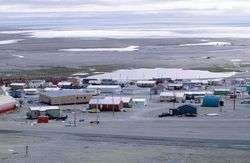 Resolute in 1997. Visible on the left is a long school building (brown). | |
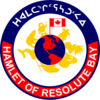 Seal | |
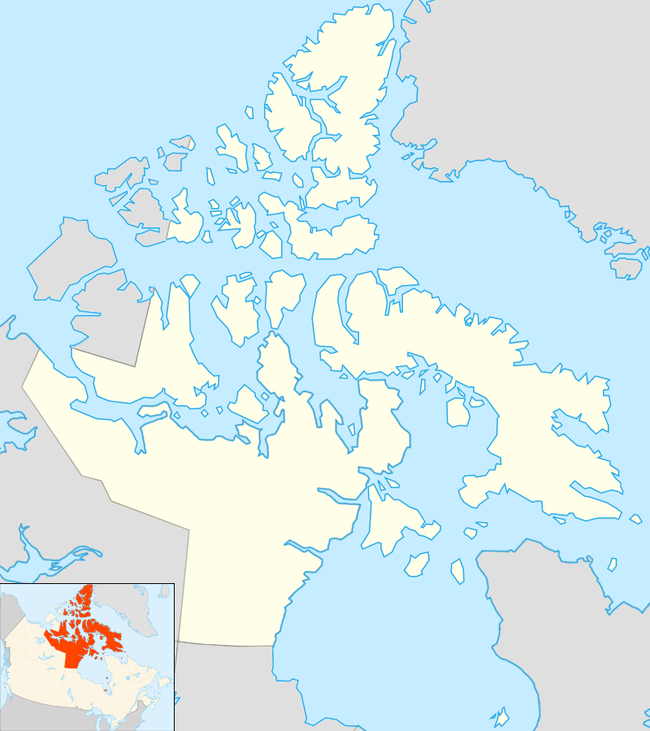 Resolute Resolute Bay  Resolute Resolute Bay | |
| Coordinates: 74°41′51″N 094°49′56″W | |
| Country | Canada |
| Territory | Nunavut |
| Region | Qikiqtaaluk |
| Electoral district | Quttiktuq |
| Government | |
| • Type | Hamlet Council |
| • Mayor | Mark Amarualik |
| • MLA | David Akeeagok |
| Area | |
| • Total | 116.89 km2 (45.13 sq mi) |
| Elevation | 66 m (217 ft) |
| Population (2016)[3] | |
| • Total | 198 |
| • Density | 1.7/km2 (4/sq mi) |
| Time zone | UTC−06:00 (CST) |
| • Summer (DST) | UTC−05:00 (CDT) |
| Canadian Postal code | X0A 0V0 |
| Area code(s) | 867 |
Resolute is one of Canada's northernmost communities and is second only to Grise Fiord on Ellesmere Island (Alert and Eureka are more northerly but are not considered towns, rather military outposts and weather stations). It is also one of the coldest inhabited places in the world, with an average yearly temperature of −15.7 °C (3.7 °F).[7] As of the 2016 census the population was 198, a decrease of 7.5% from the 2011 census.[3] As in most other northern communities, the roads and most of the terrain are all gravel.
Settlement
The area shows evidence of being occupied sporadically by the Dorset culture (Tunit) and later the Thule people from as early as 1500 BCE until 1000 CE. However, modern Inuit did not occupy or use the area until the 1953 High Arctic relocation.[8]
In 1947 Canada and the United States built a weather station, Resolute Weather Station, and an airstrip as part of the Joint Arctic Weather Stations, known today as the High Arctic Weather Stations.[8][9] This was followed in 1949 by a Royal Canadian Air Force base, RCAF Station Resolute Bay.[8] At that time the population was made up of military personnel and specialists, such as meteorologists, from the south. Today the base serves as a starting point for Arctic research and access to both the North Pole and the North Magnetic Pole.[8]
Named after the Arctic exploration vessel HMS Resolute,[8] the community of Resolute got its start in 1953 as part of the High Arctic relocation. Efforts to assert sovereignty in the High Arctic during the Cold War, because of the area's strategic geopolitical position, led the Government of Canada to forcibly relocate Inuit from northern Quebec to Resolute (and to Grise Fiord). The first group of people, which included one Royal Canadian Mounted Police officer, Ross Gibson, who was also to become the community's first teacher,[8] were relocated in 1953, along with a second group in 1955,[8] from Inukjuak, Quebec (then known as Port Harrison), and from Pond Inlet, Nunavut. They were promised homes and game to hunt, but the relocated people discovered no buildings and very little familiar wildlife.[10] They also had to endure weeks of 24-hour darkness during the winter, and 24-hour sunlight during the summer, something that does not occur in northern Quebec.
They were told that they would be returned home after a year if they wished, but this offer was later withdrawn as it would have damaged Canada's claims to sovereignty in the area and the Inuit were forced to stay. Eventually, the Inuit learned the local beluga whale migration routes and were able to survive in the area, hunting over a range of 18,000 km2 (6,900 sq mi) each year.[11]
In 1993, the Canadian government held hearings to investigate the relocation program, and the following year the Royal Commission on Aboriginal Peoples issued a report entitled The High Arctic Relocation: A Report on the 1953–55 Relocation.[12] The government paid $10 million CAD to the survivors and their families, and gave a formal apology in 2008.[13]
The community was originally built 5 km (3.1 mi) from the base but by the 1970s the number of research people arriving in Resolute was causing problems. Between 1974 and 1975 the community was moved to a location allowing better municipal services, but poorly sited for hunting purposes.[8]
Contrary to popular stereotypes, people in this remote community have a low unemployment rate. Most citizens are employed at least part of the year; however, with 2010s changes to American policy toward polar bear hunting, the local economy is at risk as many Inuit cater to American sport hunters seeking polar bear trophies.[11]
Facilities
The Tudjaat Co-op, part of the Arctic Co-operatives, runs a grocery/retail store and a hotel. There is also an airport gift shop called Polar Bear Hut.
The town has three hotels – Qausuittuq Inns North, South Camp Inn, and the Airport Hotel – which have fewer than 100 rooms each, and several lodges. Other facilities include a Royal Canadian Mounted Police Detachment, a school (which provides education from kindergarten to Grade 12) and a gym.
Limited services available with most in Iqaluit and Ottawa:[14]
- Resolute Bay Health Centre/Nursing Station
- Arctic College
- Resolute Bay Anglican Church
Broadband communications
The community has been served by the Qiniq network since 2005. Qiniq is a fixed wireless service to homes and businesses, connecting to the outside world via a satellite backbone. The Qiniq network is designed and operated by SSI Micro. In 2017, the network was upgraded to 4G LTE technology, and 2G-GSM for mobile voice.
Military presence
On August 8, 2007, CBC News reported that Canadian Forces documents showed plans to build an army training centre in the community along with a $60 million deepwater port at Nanisivik 370 km (230 mi) to the southeast.[15]
On August 10, 2007, then Prime Minister Stephen Harper announced the construction of a pair of multimillion-dollar military facilities within the contested waters of Canada's Arctic territory. The facilities consist of a new army training centre at Resolute, and a deep-sea port at Nanisivik Naval Facility. A statement issued by the Prime Minister says, "The Training Centre will be a year-round multi-purpose facility supporting Arctic training and operations, accommodating up to 100 personnel. Training equipment and vehicles stationed at the site will also provide an increased capability and faster response time in support of regional military or civilian emergency operations."[16]
On August 16, 2013, the Arctic Training Facility opened in Resolute.[17]
On February 23, 2016, in response to an increase in Russian military presence in the Arctic, it was announced that the military training facility would be expanded. This would include, "more storage, more capacity to get more equipment in, prepositioning more equipment so we don't spend a fortune on airlift or chartered aircraft", said Lt.-Col. Luc St-Denis. Incinerators were also said to be proposed to minimize the environmental impact on the area.[18]
Government of Canada facilities
The government of Canada has several buildings around the community, namely the Martin Bergmann complex which house the Polar Continental Shelf Program front Natural Resources Canada enabling Arctic Science Research.
Climate
Resolute has a polar arctic climate with long cold winters and short cool summers. Resolute's average high for the year is −12.7 °C (9.1 °F) while the average low for the year is −18.6 °C (−1.5 °F). Resolute has a very dry climate with an average precipitation of 161.2 mm (6.35 in) a year, most of it falling as snow from August to September. The record high for Resolute is 20.1 °C (68.2 °F) on July 2, 2012.[19] The record low for Resolute is −52.2 °C (−62 °F) on January 7, 1966.[7]
Resolute has never experienced an above freezing temperature between October 20 and May 6.[20]
Between around April 30 and August 13, Resolute experiences midnight sun, whilst between around November 7 and February 4 there is polar night.[21] Between late November and mid-January the sun is so low that there is not even civil twilight, with the only exception from complete darkness being a deeper blue sky called nautical twilight at noon, but there is no true experience of 24 hours of pitch black darkness around noon. For about two weeks before and after the midnight sun in Resolute, the nights are still quite bright since it does not get any darker than civil twilight (this is the twilight where surrounding objects are still visible and outdoor activities can go on without the need for artificial lighting). Resolute, however, does not experience night (the phase of day) from about March 14 to September 29.[22]
Resolute does experience thunderstorms during the summer but they are typically rare in the region.[23]
| Climate data for Resolute Bay Airport, 1981–2010 normals, extremes 1947–present | |||||||||||||
|---|---|---|---|---|---|---|---|---|---|---|---|---|---|
| Month | Jan | Feb | Mar | Apr | May | Jun | Jul | Aug | Sep | Oct | Nov | Dec | Year |
| Record high °C (°F) | −0.8 (30.6) |
−3.9 (25.0) |
−2.7 (27.1) |
0.0 (32.0) |
6.1 (43.0) |
18.3 (64.9) |
20.1 (68.2) |
15.3 (59.5) |
9.4 (48.9) |
2.0 (35.6) |
−2.8 (27.0) |
−3.6 (25.5) |
20.1 (68.2) |
| Average high °C (°F) | −28.6 (−19.5) |
−29.0 (−20.2) |
−26.8 (−16.2) |
−18.3 (−0.9) |
−7.4 (18.7) |
2.6 (36.7) |
7.3 (45.1) |
4.2 (39.6) |
−2.0 (28.4) |
−10.5 (13.1) |
−19.5 (−3.1) |
−24.5 (−12.1) |
−12.7 (9.1) |
| Daily mean °C (°F) | −32.0 (−25.6) |
−32.4 (−26.3) |
−30.2 (−22.4) |
−21.8 (−7.2) |
−10.3 (13.5) |
0.4 (32.7) |
4.5 (40.1) |
2.0 (35.6) |
−4.1 (24.6) |
−13.4 (7.9) |
−22.7 (−8.9) |
−27.9 (−18.2) |
−15.7 (3.7) |
| Average low °C (°F) | −35.3 (−31.5) |
−35.8 (−32.4) |
−33.6 (−28.5) |
−25.3 (−13.5) |
−13.3 (8.1) |
−1.9 (28.6) |
1.7 (35.1) |
−0.3 (31.5) |
−6.1 (21.0) |
−16.4 (2.5) |
−25.9 (−14.6) |
−31.3 (−24.3) |
−18.6 (−1.5) |
| Record low °C (°F) | −52.2 (−62.0) |
−52.0 (−61.6) |
−51.7 (−61.1) |
−42.1 (−43.8) |
−29.4 (−20.9) |
−16.7 (1.9) |
−3.1 (26.4) |
−9.3 (15.3) |
−20.6 (−5.1) |
−37.3 (−35.1) |
−42.8 (−45.0) |
−46.1 (−51.0) |
−52.2 (−62.0) |
| Average precipitation mm (inches) | 4.2 (0.17) |
3.9 (0.15) |
7.4 (0.29) |
6.7 (0.26) |
8.7 (0.34) |
14.6 (0.57) |
28.1 (1.11) |
33.8 (1.33) |
22.6 (0.89) |
16.0 (0.63) |
9.6 (0.38) |
5.7 (0.22) |
161.2 (6.35) |
| Average rainfall mm (inches) | 0.0 (0.0) |
0.0 (0.0) |
0.0 (0.0) |
0.0 (0.0) |
0.5 (0.02) |
7.2 (0.28) |
23.2 (0.91) |
23.2 (0.91) |
4.8 (0.19) |
0.5 (0.02) |
0.0 (0.0) |
0.0 (0.0) |
59.5 (2.34) |
| Average snowfall cm (inches) | 4.8 (1.9) |
4.3 (1.7) |
7.9 (3.1) |
6.8 (2.7) |
9.9 (3.9) |
7.7 (3.0) |
4.6 (1.8) |
10.9 (4.3) |
18.7 (7.4) |
18.9 (7.4) |
10.2 (4.0) |
6.6 (2.6) |
111.2 (43.8) |
| Average precipitation days (≥ 0.2 mm) | 5.8 | 6.0 | 7.8 | 6.6 | 8.6 | 7.7 | 11.4 | 13.6 | 12.8 | 13.1 | 9.2 | 6.7 | 109.2 |
| Average rainy days (≥ 0.2 mm) | 0.0 | 0.0 | 0.0 | 0.0 | 0.4 | 3.9 | 10.0 | 9.0 | 2.2 | 0.3 | 0.0 | 0.0 | 25.7 |
| Average snowy days (≥ 0.2 cm) | 6.3 | 6.3 | 7.9 | 6.8 | 8.9 | 5.5 | 3.2 | 6.7 | 11.6 | 13.2 | 9.5 | 7.1 | 92.9 |
| Average relative humidity (%) | 64.5 | 64.4 | 65.0 | 69.6 | 81.5 | 83.5 | 80.8 | 85.8 | 88.5 | 84.2 | 71.6 | 67.0 | 75.5 |
| Mean monthly sunshine hours | 0.0 | 0.0 | 132.2 | 291.7 | 307.9 | 298.1 | 299.4 | 138.4 | 58.9 | 30.3 | 0.7 | 0.0 | 1,557.5 |
| Percent possible sunshine | 0 | 0 | 37.2 | 53.6 | 41.4 | 41.4 | 40.2 | 20.8 | 14.0 | 12.4 | 3.8 | 0 | 29.4 |
| Source: Environment Canada[7][19][24][25] | |||||||||||||
Economy
Besides hunting guides and hotels Resolute has mixed and small sized employers:[14]
- Resolute Bay School
- Hamlet of Resolute Council
- RCMP Resolute Detachment
- Resolute Bay Airport
- Tudjaat Co-op store
Transportation
Although not as busy as it once was, Resolute Bay Airport is still the core of the area, serving as an aviation hub for exploration in the region and connected by direct service to Iqaluit.
Within the community, most travel is by snowmobile and walking. Cars are limited. There are no taxis or public transit but hotels offer shuttle service.
Notable people
Joseph Idlout, grandfather of singer Lucie Idlout and father of Leah Idlout, the community's second teacher, moved to Resolute in 1955 from Pond Inlet.[8] Idlout, an Inuk hunter who was the subject of two National Film Board documentaries, Land of the Long Day, filmed in 1952 in Pond Inlet,[26] and Between Two Worlds in 1990.[27] He was for a time one of the most well-known Inuit and was shown on the back of the Canadian two-dollar bill.[28] Celina Kalluk, notable performer of Inuit throat singing and children's author, was born here.[29]
Racing
Resolute is the starting point for both the Polar Race and the Polar Challenge, in which teams race the 350 nautical miles (648 km; 403 mi) to the North Magnetic Pole.
In 2007, the British television team Top Gear embarked from Resolute and became the first team to reach the 1996 position of the North Magnetic Pole with automobiles, with Jeremy Clarkson and James May reaching the Pole in a United Kingdom plated 2007 Toyota Hilux 3.0 litre diesel, heavily modified by an Icelandic team on a mixture of diesel and avgas, against Richard Hammond who was being pulled by a team of sled dogs.[30]
Image gallery
 Resolute Bay, Nunavut, 2002
Resolute Bay, Nunavut, 2002 Resolute at Sundown, 2002
Resolute at Sundown, 2002 Stone Cairn, 2002
Stone Cairn, 2002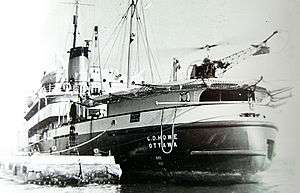 The C.D.Howe that brought the first people to Resolute, 1955
The C.D.Howe that brought the first people to Resolute, 1955 Resolute Area, 2004
Resolute Area, 2004 Tadjaat Coop Hotel under the midnight sun, July 2004
Tadjaat Coop Hotel under the midnight sun, July 2004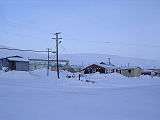 The community of Resolute
The community of Resolute
See also
References
- Nunavummiut elect new municipal leaders
- Results for the constituency of Quttiktuq Archived November 13, 2013, at the Wayback Machine at Elections Nunavut
- "Census Profile, 2016 Census". Statistics Canada. Retrieved March 3, 2017.
- Elevation at airport. Canada Flight Supplement. Effective 0901Z 30 January 2020 to 0901Z 26 March 2020.
- Resolute at the Government of Nunavut
- The Nunavut Handbook ISBN 1-55036-587-8
- "Resolute CARS". Canadian Climate Normals 1981–2010. Environment Canada. Climate ID: 2403500. Retrieved January 13, 2016.
- "Resolute Bay Community History". Archived from the original on July 15, 2011. Retrieved January 5, 2010.
- High Arctic Weather Stations
- Grise Fiord: History Archived December 28, 2008, at the Wayback Machine
- McGrath, Melanie. The Long Exile: A Tale of Inuit Betrayal and Survival in the High Arctic. Alfred A. Knopf, 2006 (268 pages) Hardcover: ISBN 0-00-715796-7 Paperback: ISBN 0-00-715797-5
- The High Arctic Relocation: A Report on the 1953–55 Relocation by René Dussault and George Erasmus, produced by the Royal Commission on Aboriginal Peoples, published by Canadian Government Publishing, 1994 (190 pages)
- Royte, Elizabeth (April 8, 2007). "Trail of Tears". The New York Times.
- "Archived copy". Archived from the original on August 27, 2011. Retrieved August 21, 2011.CS1 maint: archived copy as title (link)
- Planned army base, port in North heat up Arctic quest
- Prime Minister Announces Expansion of Canadian Forces Facilities and Operations in the Arctic Archived November 15, 2007, at Library and Archives Canada, Government of Canada news release, 10 August 2007.
- "Military's Arctic training facility opens in Resolute". CBS News. August 16, 2013.
- News; Canada (February 23, 2016). "Canadian Forces to expand Nunavut training centre as Russia plans more bases in the Arctic | National Post". Retrieved September 25, 2019.
- "Daily Data Report for July 2012". Canadian Climate Data. Environment Canada. Climate ID: 2403500. Retrieved July 11, 2016.
- http://climate.weather.gc.ca/climate_data/almanac_e.html?hlyRange=1953-01-01%7C2014-11-06&dlyRange=1947-10-01%7C2014-11-05&mlyRange=1947-01-01%7C2014-09-01&StationID=1776&Prov=NU&urlExtension=_e.html&searchType=stnName&optLimit=yearRange&StartYear=1840&EndYear=2016&selRowPerPage=25&Line=2&searchMethod=contains&month=5&day=7&txtStationName=resolute&timeframe=4&year=2017&Year=2017
- "Sunrise and sunset for Resolute Bay". Time and Date.com. Retrieved January 16, 2016.
- "Sunrise and sunset times in Resolute Bay". www.timeanddate.com. Retrieved April 8, 2016.
- Hudson, Ed; Aihoshi, David; Gaines, Tim; Simard, Gilles; Mullock, John. "The Weather of Nunavut and the Arctic" (PDF). NAV Canada. NAV Canada. p. 115. Retrieved July 3, 2016.
- "Daily Data Report for June 2012". Canadian Climate Data. Environment Canada. Climate ID: 2403500. Retrieved July 11, 2016.
- "Daily Data Report for October 2014". Canadian Climate Data. Environment Canada. Climate ID: 2403500. Retrieved July 11, 2016.
- Land of the Long Day
- NFB Collection: Between Two Worlds
- Contact with Europeans
- Celina Kalluk at Strong Nations
- Top Gear Team in Hot Water Over Pole Race
Further reading
- Bissett, Don. Resolute, An Area Economic Survey. Ottawa: Industrial Division, Dept. of Indian Affairs and Northern Development, 1968.
- Canadian Ice Service. Present and future sea ice travel: Resolute Maannaujuq ammalu sivuniksattinni sikukkut aullaaqattarniq: Qausuittuq = Déplacements actuels et futurs sur la glace de mer: Resolute. Ottawa: Canadian Ice Service = Service Canadien des glaces, 2007. ISBN 978-0-662-49881-0
- Lahoutifard, Nazafarin, Melissa Sparling, and David Lean. 2005. "Total and Methyl Mercury Patterns in Arctic Snow During Springtime at Resolute, Nunavut, Canada". Atmospheric Environment. 39, no. 39: 7597.
External links
| Wikimedia Commons has media related to Resolute, Nunavut. |
- Resolute Bay 1961, British Pathe Newsreel – New Arctic Station